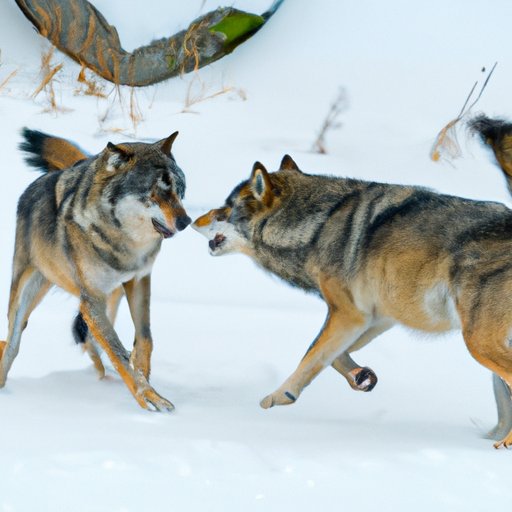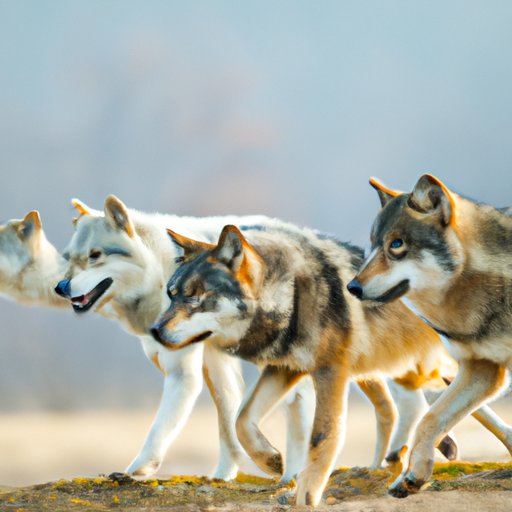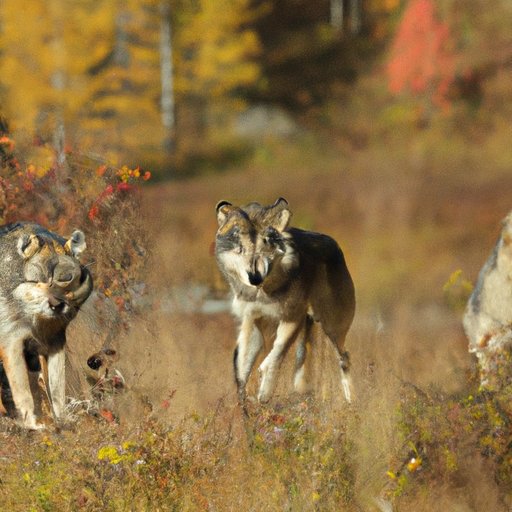Introduction
For centuries, scientists have been fascinated by the way wolves travel in large groups, known as wolf packs. While the behavior of individual wolves is fairly well understood, much less is known about the social structure and migration patterns of wolf packs, making them an interesting and complex subject of study. In this article, we will explore the various aspects of wolf pack travel to gain a better understanding of how these creatures navigate and claim their territories, the benefits they receive from group movement, and the challenges they face when on the move.

Describing the Territory of a Wolf Pack: How Wolves Navigate and Claim Their Territory
The first step in exploring wolf pack travel is to understand how wolves navigate and claim their territory. Wolves are territorial animals, and they use a variety of methods to identify and map out the boundaries of their home range. This includes scent marking, vocalizations, and physical displays of dominance.
Identifying Territories
According to research conducted by the National Wildlife Federation, wolves use their keen sense of smell to identify and claim their territories. They mark their boundaries with urine and feces, which contain pheromones that help to deter other wolves from entering their space. Additionally, wolves will often howl or bark to let others know that they have claimed a certain area. This helps to keep the peace between neighboring wolf packs, as each wolf knows where its territory begins and ends.
Mapping Territory
In addition to scent marking and vocalizations, wolves also use visual cues to map out their territory. When a wolf pack moves through an area, they will often leave behind markers such as tracks, scat, fur, and feathers. These markers serve as a reminder of the pack’s presence and can help the wolves remember where they have been and where they are going.
Establishing Boundaries
Once a wolf pack has identified and mapped out its territory, it will begin to establish boundaries. Wolves will patrol their territory regularly to make sure that no other wolves are encroaching on their space. If another animal does enter the territory, the wolf pack may display aggressive behavior to scare off the intruder or even attack if necessary.
Exploring the Social Structure of a Wolf Pack: The Dynamics of Wolf Pack Travel
The next step in understanding wolf pack travel is to examine the social structure of the pack itself. Wolf packs are typically made up of family members, including parents, siblings, and offspring. Within the pack, there is usually a hierarchical structure with the alpha pair at the top.
Alpha Wolves
The alpha pair is typically the strongest and most dominant wolves in the pack. According to a study published in ScienceDirect, the alpha pair is responsible for leading the pack and making decisions about where they will go, when they will hunt, and how they will defend their territory. All other wolves in the pack must follow the commands of the alpha pair, otherwise they risk being exiled from the pack.
Leadership Hierarchy
Below the alpha pair, there is a leadership hierarchy within the pack. Lower ranking wolves must submit to the authority of higher ranking wolves and act according to their commands. This is important for maintaining order within the pack and ensuring that all of the wolves work together towards a common goal.
Social Interactions
In addition to the hierarchical structure, wolf packs also engage in social interactions with one another. Wolves will often groom each other, play together, and even share food. These social interactions help to create strong bonds between the wolves and ensure that they remain loyal to one another.

Mapping the Migration Patterns of Wolf Packs: Understanding the Habits of Wolves on the Move
Now that we have examined the social structure of a wolf pack, let’s take a look at their migration patterns. Wolves are nomadic creatures, meaning that they are constantly on the move. They travel long distances in search of food, water, and shelter and will often migrate seasonally in order to find the best resources.
Seasonal Migration
According to a study conducted by the University of Alberta, wolves tend to migrate seasonally in search of food and shelter. During the winter months, they will often move to lower elevations where they can find more abundant prey. In the summer, they may move to higher elevations where they can find cooler temperatures and more cover from predators.
Distance Traveled
On average, wolves will travel between 5 and 20 miles per day while they are on the move. However, some wolves may travel as far as 100 miles in a single day if they are searching for a new territory or if they are following a large prey animal. Wolves will also occasionally backtrack on their path if they want to revisit an area or if they are looking for food.
Factors Influencing Movement
There are several factors that can influence the movements of a wolf pack. These include weather conditions, availability of food and water, presence of predators, and conflicts with other wolf packs. Wolves will adjust their movements accordingly in order to ensure their safety and maximize their chances of finding resources.

Examining the Benefits of Wolf Pack Travel: How Wolves Benefit from Group Movement
Now that we have discussed the migration patterns of wolf packs, let’s take a look at the benefits they receive from group movement. Wolves are social animals, and traveling in a pack provides numerous advantages that would not be available to them if they were to travel alone.
Increased Safety
One of the biggest benefits of wolf pack travel is increased safety. By traveling in a group, wolves are better able to protect themselves from predators and other threats. A larger group is more intimidating and can ward off potential attackers more effectively than a lone wolf.
More Effective Hunting
Another benefit of wolf pack travel is that it makes it easier for the wolves to hunt for food. Wolves are highly intelligent hunters and they use sophisticated strategies to take down their prey. By working together, they can increase their chances of success and bring home more food for the pack.
Increased Opportunities
Finally, traveling in a pack also increases the opportunities available to the wolves. By covering more ground, the wolves are able to find new sources of food, explore new territories, and meet new members of their species. This can lead to greater success for the pack as a whole.
Investigating the Challenges of Wolf Pack Travel: What Difficulties Do Wolf Packs Face When On the Move?
While traveling in a pack has numerous benefits, it also comes with some challenges. Wolves must constantly be on the lookout for danger and they must be mindful of the resources available to them in order to ensure their survival.
Lack of Resources
One of the biggest challenges that wolf packs face is a lack of resources. As they travel, they must constantly be on the lookout for food, water, and shelter. If these resources become scarce, the wolves may have difficulty sustaining themselves and may need to move on to a different area.
Predation from Other Animals
Another challenge that wolf packs face is predation from other animals. Wolves are apex predators, but they are still vulnerable to attacks from larger predators such as bears or mountain lions. To protect themselves, the wolves must stay alert and stick together as a pack.
Disagreements Within the Pack
Finally, disagreements within the pack can also be a challenge. Wolves are social animals, but they do not always agree on the best course of action. This can lead to arguments and disputes, which can disrupt the group’s unity and put the pack at risk.
Conclusion
In conclusion, wolf pack travel is an incredibly complex behavior that scientists are still trying to understand. By examining the social structure and migration patterns of wolf packs, we can gain a better understanding of how these animals navigate and claim their territories, the benefits they receive from group movement, and the challenges they face when on the move. With further research, we can continue to learn more about the fascinating behavior of wolves and how they interact with their environment.
Summary
This article explored the various aspects of wolf pack travel, including how wolves navigate and claim their territory, the dynamics of wolf pack travel, the benefits and challenges of group movement, and other factors influencing wolf pack travel. We learned that wolves use their keen sense of smell to identify and claim their territories, that they have a hierarchical structure with the alpha pair at the top, and that they migrate seasonally in search of food and shelter. We also saw that wolf pack travel provides numerous benefits such as increased safety, more effective hunting, and increased opportunities, but that it also comes with some challenges such as a lack of resources, predation from other animals, and disagreements within the pack.
Recommendations for Solving Problem
In order to better understand wolf pack travel, researchers should focus on gathering data from field studies and tracking the movements of wolf packs over time. By doing so, we can gain a better understanding of the behavior of these animals and the factors that influence their movements. Additionally, conservation efforts should be put in place to protect wolf habitats and ensure that these animals are able to roam freely without fear of predation or human interference.
(Note: Is this article not meeting your expectations? Do you have knowledge or insights to share? Unlock new opportunities and expand your reach by joining our authors team. Click Registration to join us and share your expertise with our readers.)
